
Friday, May 31, 2013
Solar System
Last in my little mini-series on the images from my new banner is Nathan Sawaya's sculpture of the solar system. Nathan notes that he tried to put them in roughly relative scales, but he also notes that he's an artist, not a scientist. For a great side-by-side comparison tool, go to this link, that lets you compare the various planets to each other. Nathan also insists on including Pluto atop his sculpture. Seven years ago there was a debate in the International Astronomical Union about the status of Pluto. It turns out there are at least four other similarly-sized rocks out there (and Eris is bigger than Pluto). Rather than have a constantly expanding solar system as further celestial bodies are discovered, the IAU came up with classifications of 'planet' (Mercury, Venus, Earth, Mars, Jupiter, Saturn, Uranus, Neptune), and 'dwarf planet' (Pluto and friends). Due to tradition, and quite possibly due to the connection with the Disney cartoon dog, many have resisted the reclassification of Pluto (for instance, it was a subplot of an episode of the sitcom Sports Night).


Thursday, May 30, 2013
DNA
Continuing with my mini-focus on the models in my new banner, DNA's double helix (here by Andreas) is one of the most widely recognized structures from modern science. This wasn't always true. By the 1940's it was commonly accepted that DNA held the key to genetic information. It was known that DNA was made of four bases - G, C, A, and T - and also sugars and phosphates, but it was not known how these came together. Erwin Gargaff discoverd that each cell had an equal number of G's and C's, and also an equal number of A's and T's. Linus Pauling proposed a structure that involved a triple helix, with the phosphates on the insides. At this time, Rosalind Franklin was doing some ground breaking work on X-ray crystallography, and she determined that the structure involved a double helix, and the phosphates must be on the outside. Watson and Crick put this information together, and they came up with the now famous double helical structure shaped like a twisted ladder, where the outside strands (the blue bricks in this LEGO model) are comprised of repeating sugar-phosphate units, and the rungs of the ladder (the red and yellow here) are pairs made up of either A and T or G and C bases. Their paper describing the structure has one of the best lines ever in science writing: "This structure has novel features which are of considerable biological interest." Indeed, the base-pairing and the double helix are at the heart of explaining how DNA is copied, bringing information to the next generation of cells, and also explaining how DNA is used by the cell to make proteins.

BTW, the elucidation of DNA's structure is a great story of egos and infighting, probably sexism, and accusations of international politics. Franklin didn't get much credit for her discoveries because another scientist, Wilkins (another DNA researcher who eventually shared the Nobel with Watson and Crick) shared her data with Crick without asking her first. After she left Kings College, the research director there refused to let her continue on with her data, so she turned to other subjects, where she made ground-breaking discoveries on tobacco mosaic virus and polio virus. So one of her key papers was not even published until after her death. Another interesting side story is that Linus Pauling reportedly felt he would have come up with the structure first if he hadn't missed a flight due to passport issues, so he didn't see a talk by Franklin where she shared some of her results. The Wikipedia entry disputes the significance of this missed flight, but I first heard the story at a conference in honor of Pauling on the occasion of his 90th birthday, where several of his former students gave talks. BTW, he was there at the start of the conference, but I didn't make it until the afternoon session, so I didn't get to see him.

BTW, the elucidation of DNA's structure is a great story of egos and infighting, probably sexism, and accusations of international politics. Franklin didn't get much credit for her discoveries because another scientist, Wilkins (another DNA researcher who eventually shared the Nobel with Watson and Crick) shared her data with Crick without asking her first. After she left Kings College, the research director there refused to let her continue on with her data, so she turned to other subjects, where she made ground-breaking discoveries on tobacco mosaic virus and polio virus. So one of her key papers was not even published until after her death. Another interesting side story is that Linus Pauling reportedly felt he would have come up with the structure first if he hadn't missed a flight due to passport issues, so he didn't see a talk by Franklin where she shared some of her results. The Wikipedia entry disputes the significance of this missed flight, but I first heard the story at a conference in honor of Pauling on the occasion of his 90th birthday, where several of his former students gave talks. BTW, he was there at the start of the conference, but I didn't make it until the afternoon session, so I didn't get to see him.
Wednesday, May 29, 2013
Platonic solids
The Platonic solids (here by OptimalControl) are defined as polyhedra (three dimensional solids) comprised of regular polygonal faces, arranged such that the same number come together at every vertex. The tetrahedron, octahedron, and icosahedron, each comprised of equilateral triangles, the cube made up of squares, and the dodecahedron made of regular pentagons, are the only polyhedra that match this description. These were described by Plato in the Timaeus dialogue, hence the name. He associated the first four with the elements fire, air, water, and earth, respectively, and the dodecahedron with the heavens. BTW, I know this is a LEGO-centric blog, and I try to stick to that, but if you are interested in geometric shapes like these, you might want to check out Magformers, a building toy made up of regular polygons with magnets along the edges, so they can easily click together to make various polyhedra.
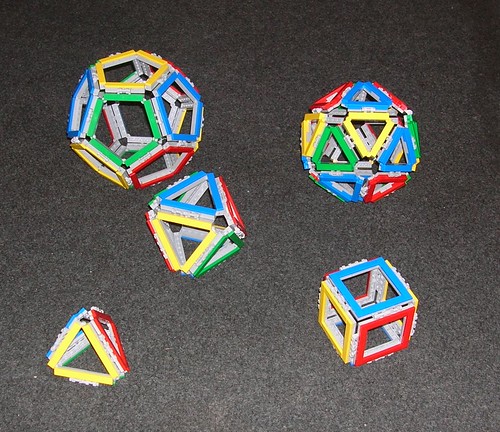
From the Timaeus:

From the Timaeus:
The first will be the simplest and smallest construction, and its element is that triangle which has its hypotenuse twice the lesser side. When two such triangles are joined at the diagonal, and this is repeated three times, and the triangles rest their diagonals and shorter sides on the same point as a centre, a single equilateral triangle is formed out of six triangles ; and four equilateral triangles, if put together, make out of every three plane angles one solid angle, being that which is nearest to the most obtuse of plane angles ; and out of the combination of these four angles arises the first solid form which distributes into equal and similar parts the whole circle in which it is inscribed. The second species of solid is formed out of the same triangles, which unite as eight equilateral triangles and form one solid angle out of four plane angles, and out of six such angles the second body is completed. And the third body is made up of 120 triangular elements, forming twelve solid angles, each of them included in five plane equilateral triangles, having altogether twenty bases, each of which is an equilateral triangle. The one element [that is, the triangle which has its hypotenuse twice the lesser side] having generated these figures, generated no more ; but the isosceles triangle produced the fourth elementary figure, which is compounded of four such triangles, joining their right angles in a centre, and forming one equilateral quadrangle. Six of these united form eight solid angles, each of which is made by the combination of three plane right angles ; the figure of the body thus composed is a cube, having six plane quadrangular equilateral bases. There was yet a fifth combination which God used in the delineation of the universe.
Monday, May 27, 2013
Formaldehyde
You might have noticed that I'm making some slight changes to the look of this blog, including the graphics added to the banner at the top of this page. I tried to choose some models from a few (but by no means all) of the major disciplines covered on this blog - chemistry, math, biology and astronomy. Let's take a few blog posts to look at the models I used. Starting at the left end with one of my own, here is my model of formaldehyde (shown next to a standard organic chemistry model kit version). Formaldehyde is made up of one atom of carbon (shown in black), with a double bond to an atom of oxygen (red) and two bonds to hydrogen atoms (white). One thing that is demonstrated by this model is the shape of formaldehyde. Molecular shape is driven by VSEPR - Valence Shell Electron Pair Repulsion theory. The bonds (gray lines) are made up of negatively chaged electrons, and, since like charges repel, those bonds push each other away. VSEPR says that the best (lowest energy) arrangement of bonds will maximize the distance between the bonds. Here we have three sets of bonds around carbon, and the furthest they can get from each other is 120 degree angles (360 / 3).
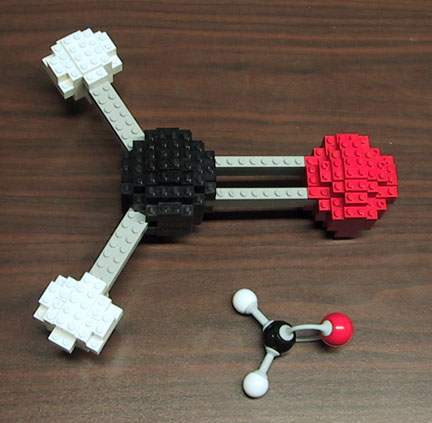

Friday, May 24, 2013
Inventing Our Future of Flight
I just ran across a press release that NASA and LEGO will be sponsoring a contest along the theme of Inventing Our Future of Flight this summer. Details will be forthcoming and I'll post them here when I find them.
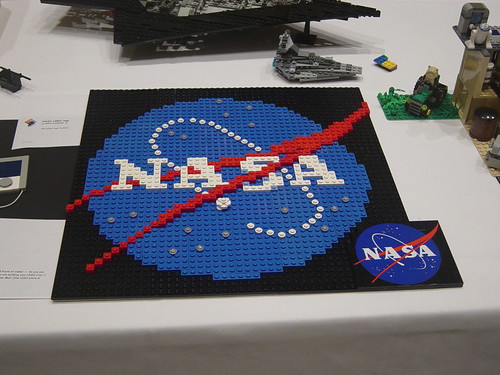
NASA logo by Galen Fairbanks

NASA logo by Galen Fairbanks
Tuesday, May 21, 2013
Colossus Mark 2
James Pegrum built the Colossus Mark 2:

1944AD 1st June, Bletchley Park, England. The improved Colossus Mark 2 starts working in time for the Normandy Landings.
The Colossus was the world's first electronic digital computer that was at all programmable. It was designed by Tommy Flowers to solve a problem posed by a mathematician, Max Newman. In December 1943 the prototype, Colossus Mark 1, was shown to work. There were ten Colossus computers in use at the end of the second world war.
The computers were used by British code breakers, giving the Allies valuable intelligence, obtained from reading many encrypted high-level telegraphic messages between the German High Command and their army commands.

Monday, May 20, 2013
Newton's cradle
I've previously described a Newton's cradle, a desktop toy that demonstrates the conservation of momentum. Derfel Cadarn has built another LEGO version.
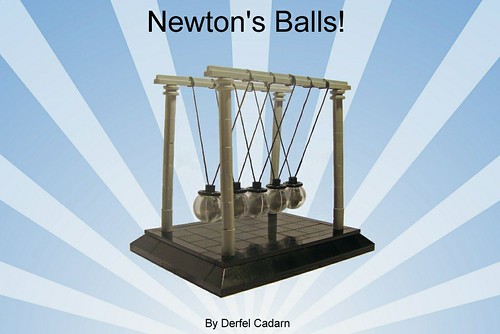

Sunday, May 19, 2013
Lunniy Korabl
The LK Moon Lander (here by Kei_Kei_Flic) was a planned Soviet landing vessel in the late 60's, roughly the equivalent of the Apollo LM. After Americans were the first to reach the moon, and following setbacks in their own space program, the Soviets decided to scrap the mission and instead to focus on orbiting space stations.


Friday, May 17, 2013
Leonardo
Leonardo da Vinci (here by Legopard) was the ultimate Renaissance man. Of course he is known for his art, but he was also a scientist. His notebooks are full of his observations of anatomy and botany, his inventions in many areas, and his writings on geometry, the formation of fossils, the flow of rivers and the reflection of light off the moon.
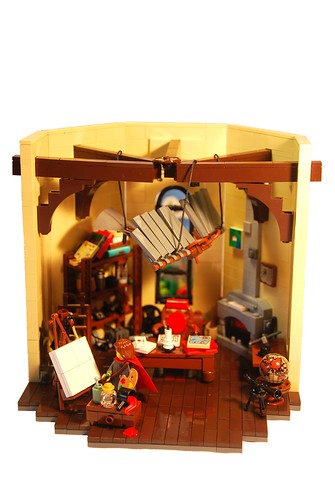

Thursday, May 9, 2013
LEGO math fun
I spent some time doing LEGO math with my 4-year-old today. Phase 1, numbers - build stacks for each number 1-9 and put them in order. Phase 2, addition - combine stacks and see what they make. Phase 3, subtraction - take away bricks from a stack.
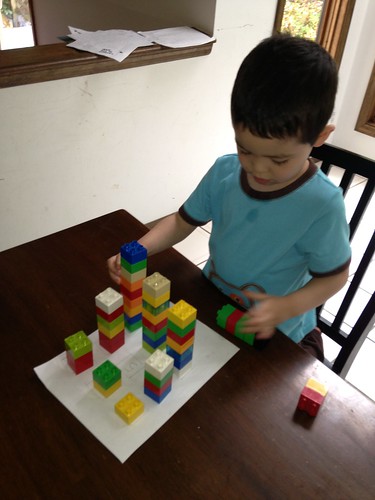

BTW, that's 1-year-old's hand just behind her brother in the second picture, and that's her artwork on the wall. Each kid has gone through this write-on-the-wall stage. Time to paint the kitchen again. :(


BTW, that's 1-year-old's hand just behind her brother in the second picture, and that's her artwork on the wall. Each kid has gone through this write-on-the-wall stage. Time to paint the kitchen again. :(
Wednesday, May 8, 2013
Simple machine: screw
A screw is a machine that transforms rotational motion to linear motion. When you turn a wood screw, for instance, you are adding torque, or rotational force, but the screw translates this to a forward force, pulling the screw into the wood. An Archimedes screw (known since at least the third century BC and attributed to the Greek mathematician) uses this concept to lift water. Here are two LEGO versions of Archimedes screws to move little balls up a slope, both by Akiyuky. BTW, these were built as modules in Great Ball Contraption layouts. The GBC is a collaborative LEGO project where people build different modules that move balls from point A to point B. These modules all get strung together to make huge mechanism that are fascinating to watch.
Tuesday, May 7, 2013
Simple machine - wedge
Another machine that is so simple that it is easy to overlook is the wedge. The idea of a wedge is that due to the angled shape, as it is pushed forward, force is exerted outward (at right angles to the path of the wedge. Think, for instance, of a log splitter - you put the log splitter in the top of the log and hit downward with a sledgehammer. You are exerting force downward on top of the log splitter, but the result pushes the two halves of the log outward. Or even just an axe is a simple example of a wedge, with really the same idea. Axe by Demonhunter.
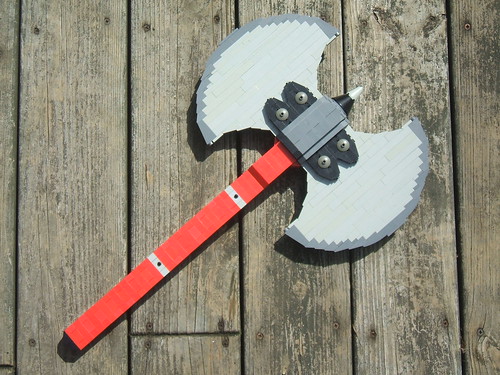
You killed Kenny! You b... by dm_meister


You killed Kenny! You b... by dm_meister

Friday, May 3, 2013
Simple machine: inclined plane
I got sidetracked from my series on simple machines. The next classical machine is perhaps the simplest of all, the humble inclined plane - a flat surface set at an angle connecting levels at different heights. I can see why some might not refer to a ramp as a 'machine,' but it fits the definition of changing the direction or magnitude of some force. When you push forward on a load sitting on the inclined plane, the slope of the surface translates part of that force into upward motion. Also, as anyone who's ever moved some heavy furniture into a U-Haul knows, it takes less force to move something along a ramp than it does to move it straight upward. You don't get something for nothing, though. To get this advantage you have to move the load over a longer distance, as the ultimate amount of work (force times distance) is the same. We see this in action in a moving truck by DadventureDan.
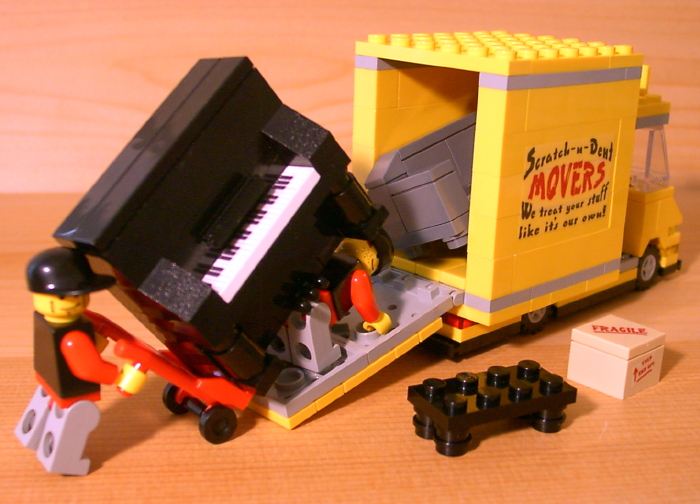

Thursday, May 2, 2013
God speed, John Glenn
BMW_Indy made this great rendition of the launch of Friendship 7, taking John Glenn aloft to be the first American to orbit the earth.


Wednesday, May 1, 2013
Breaking Bad, the video game
As a chemist, Breaking Bad is a pretty fun show to watch. Not only is the protagonist a chem teacher, but they sneak in little nuggets of real science here and there. Brian Anderson made this parody of a Breaking Bad video game based on the style seen in the various LEGO games.
Subscribe to:
Comments (Atom)